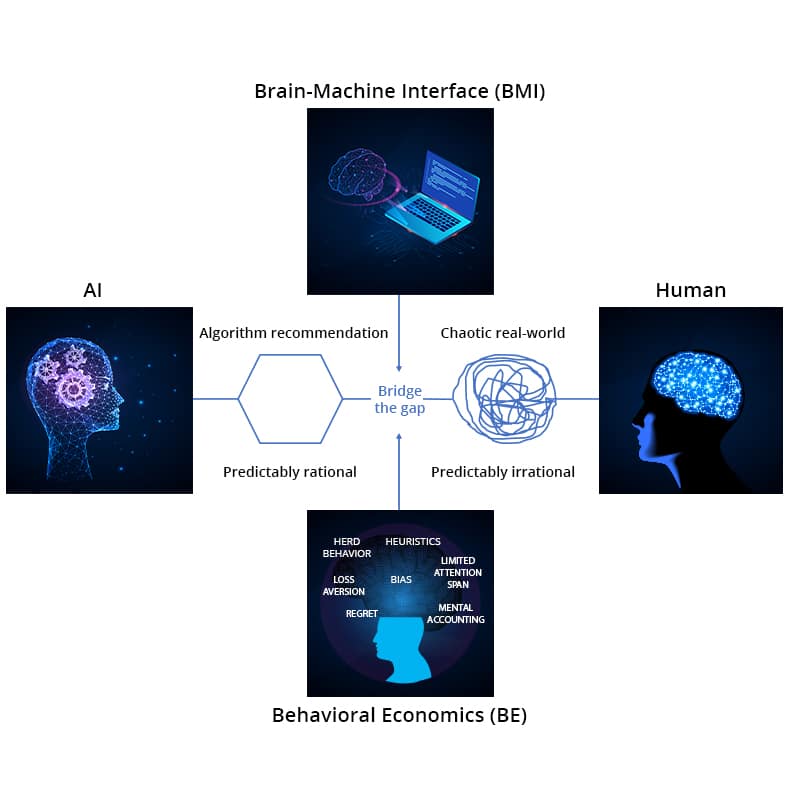Bridging the Human-AI Gap with Behavioral Economics and Brain-Machine Interface Analysis
Artificial Intelligence (AI) is becoming integral and mainstream in enterprise digitization and transformation. While the ongoing pandemic has accelerated digital implementations, AI has started to play a growing role in driving consumer insights for predictive personalization, customer experience optimization, marketplace decision-making and other areas. Yet, there’s still a gap in between how AI thinks humans will respond and behave in a certain context—and how humans actually do. And that’s got something to do with how AI algorithms are designed.
The latest advances in AI, especially in deep neural networks, have largely been driven by our understanding of the structure of the human brain and how it functions. Neural networks are built similar to the architecture of the brain since the objective is to create machines that can perceive, think, comprehend, and act like humans. The data trails left by humans and machines have provided lots of data for algorithms to learn from and mature. These algorithms have become quite robust as they learn from billions of parameters and have the potential to surpass humans in many mundane tasks, especially the ones involving less creativity. The algorithms have done exceedingly well in simulating machine failure modes, predicting failure etc.
However, AI algorithms have been more successful in a world of machines than in the world of humans.
For example, AI algorithms have been better off in predicting a machine failure than predicting if a customer would buy the next-best recommended product. It has been a mixed bag for algorithms since the real world of humans is quite chaotic. Human decision can be influenced by multiple factors such as gender, age, culture, socio-economic status, past experience, cognitive biases, emotional state (We can act differently to an offer on a Monday morning compared to a Friday evening!) etc. AI Algorithms with their current level of maturity have a long way to go to understand the vagaries of human thinking, emotions, cultural nuances, and biases.
If algorithms must achieve their intended objectives in predicting human behavior, they need to understand how humans behave in various situations. The combination of Behavioral Economics (BE) and Brain-Machine Interface (BMI) technology has immense potential to traverse the last mile in understanding customers and offer the best AI-driven solutions for them.

Figure 1. Bridging the Human-AI Gap with Behavioral Economics and Brain-Machine Interface Analysis
What is behavioral economics and how can it augment AI?
Behavioral Economics (BE) studies the effects of psychological, cognitive, emotional, cultural, and social factors on the decisions of individuals and institutions and how those decisions vary from those implied by classical economic theory.
As per various experiments conducted by behavioral scientists, it has been observed that humans are not 100% rational. We are emotional creatures and not always predictable. Over 95% of decisions we take are automatic and do not involve cognitive processing at all. It is mostly done automatically by the subconscious and is subject to many behavioral aspects like availability heuristics, status quo bias and many other cognitive biases. The decision-making is quite fast, could vary from one human to another and may not be the most optimal in all situations. One of the prime objectives of AI technologies is to complement humans, augment their capabilities and create an enduring Human-AI world. To advance further on this objective it is important for algorithms to understand how humans make decisions and support them in making decisions that are more beneficial to humans.
Blending BE with AI
Let us illustrate the application of BE in the e-Commerce world. E-Commerce platforms offer a wide variety of choices for individuals to explore different products and brands and avail promotions to gain maximum benefit.

However, this choice is overwhelming in most situations. A person who wants to buy a laptop or a mobile phone or any other product is provided with thousands of options and that makes the selection difficult for the user. A user with even a clear state of mind gets confused with overwhelming information and the innumerable choices cause cognitive overload due to which decision making is impacted. Confusion and ambiguity could make users procrastinate or abandon the buying decision or even make a wrong choice that they might regret later. This is a classic situation where a combination of AI and BE can come to the rescue.
Choice Architecture, proposed by Nobel laureate Richard Thaler in his book Nudge, is one such tool that can reduce the friction and facilitate decision-making. Choice architecture helps provide a series of initial options (say first set of 3 products) and then a subsequent set of options (next set of 3 products) and so on. Limiting the number of best choices at any point in time helps humans make better decisions. From an AI perspective, a “Nudge Bot” should engage the user in a conversation to understand what type of product the user is looking for, what is the primary utility the user intends to accomplish with the product, what price they intend to pay, what is the current product they use etc. Based on users’ responses the bot should recommend the most suitable products that fulfill the user’s needs without overwhelming them with a deluge of products.
For example, if the user is looking for a laptop that they primarily plan to use for browsing, communication, word processing etc., the choice architecture should provide laptop configurations compatible for a home office (CPU) than one suited for expert gamers (GPU). Similarly, the number of megapixels is a big marketing gimmick in the mobile phone world. If the utility is to capture photos and view them on a mobile or PC or print a 4 X 6-inch photograph, the user may not need a 64 MP camera for that, a lower configuration would suffice! Currently, people live in a busy, digitally distracted world and are unable to devote enough time to think deeply and make the appropriate choice. The objective of choice architecture is to provide relevant choices and guide the user to select the right one that is in their interest. Providing the most apt recommendations in this manner enables better conversion than blindly displaying a catalog of products purely based on user clicks, searches, and filters.
Loss aversion is another interesting phenomenon which we humans are known for. Research shows that losses make us feel hurt twice more than gains make us feel good. Losses cause us more pain and regret and we tend to avoid situations that allude to losses. We often delay purchases when we believe that the price of the product is expected to fall in coming days. Significant effort is required to overcome this inertia and status quo bias.
Leading ecommerce platforms have applied BE techniques such as price anchoring (establishing a price point as reference and offering a discount on that), framing (messages like 90% fat-free butter instead of butter with 10% fat), scarcity creation (only 1 left in stock, showing a progress bar with depleting inventory), social proof (over 1000 people have bought this product in the last 24 hours), decoy effect (nudging the customer to select from two favorable options by providing a third unfavorable option), etc.

These techniques help to overcome human inertia, procrastination, status quo bias, etc. The BE module can be added as an additional block in the AI pipeline that consists of next-best recommendation algorithms like collaboration filtering, knowledge graph, etc. thereby providing the most optimal and easier options the customer can choose from. While BE offers lot of good techniques to guide the customer to make a choice, its equally important for organizations to not be greedy, manipulative, and exploitative and take advantage of the customer’s inherently flawed decision-making approach. Such an approach will eventually turn away customers in the long run.
Brain-Machine Interface and its relevance for AI
In recent years, the use of BMI in AI applications has been an interesting technology trend highlighted by many analyst firms. BMI helps record brain activity when exposed to various stimuli like images, videos, websites, etc. While BMI has various applications in the medical field for patient care, it has great potential in consumer applications, ecommerce, gaming, and many other areas as well. Using various devices that can be attached to the human body, it can capture EEG (Electroencephalograph) signal, GSR (Galvanic Skin Response) signal, BVP (Blood Volume Pulse), and eye tracker data.

This data helps to understand visual attention and brain activity such as cognitive workload, level of engagement, valence, arousal, memorization, visual attention, emotional activation, and impact. While there are user surveys and other means of capturing user feedback, when users do not have adequate resources to consume, analyze, process, and provide feedback, they may not be able to explain what they do and why they behave or act in a certain way. This leads to inaccurate feedback and could lead to wrong decisions.
BMI has lots of potential in understanding brand perception and impact of advertising, product design, packaging, user interface/experience design and point of sale factors. Understanding how the Brain-Machine Interface works helps answer questions such as –
Is the brand positively perceived? What emotions does it trigger? Is the advertisement attracting attention, engaging viewers, and communicating the right messages? Which part of the package is salient and gets most attention? What emotions does the customer experience during shopping?
When user surveys are augmented with inputs from BMI analysis, it is a force multiplier in understanding customer thinking and in planning the right intervention strategies. AI algorithms can be trained to understand patterns of brain activity when exposed to different stimuli and use correlation with survey data to predict human behavior for new stimuli. Bringing together Behavioral Economics, Brain-Machine Interface principles and Artificial Intelligence technologies can unearth many unknown aspects of human behavior and discover the hidden forces that drive our decisions.
It is important to accept and understand this aspect of human nature and devise solutions that can bridge the gap between algorithmic recommendations and real-world situations. BE, BMI, and AI are complementary and provide the perfect set of tools to traverse the last mile and capture customer hearts.

Jayachandran Ramachandran
Jayachandran has over 25 years of industry experience and is an AI thought leader, consultant, design thinker, inventor, and speaker at industry forums with extensive...Read More

Don’t miss our next article!
Sign up to get the latest perspectives on analytics, insights, and AI.






